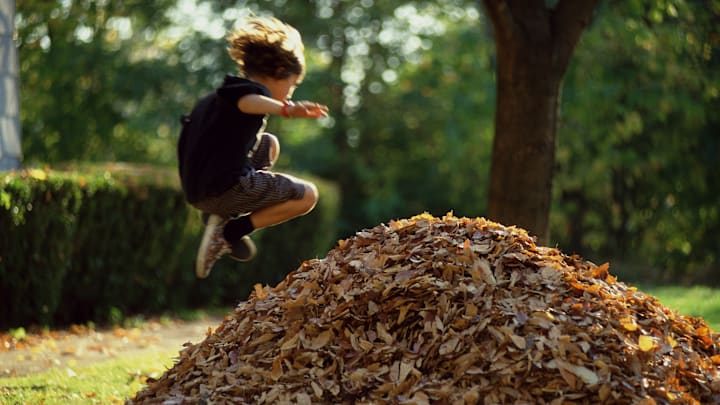If you’re lucky enough to live somewhere with iconic, vibrant autumns, you’re probably familiar with the other side of that experience: leaves everywhere. Watching those orange, yellow, and red leaves fall to the ground can feel a little less gratifying knowing you’ll have to rake them all into piles later.
Still, those raked leaf piles present their own opportunities for fun. From Charlie Brown and Snoopy to Calvin and Hobbes, leaping full-force into a mound of leaves is a classic way to enjoy the outdoors once summer wanes.
It’s hard to imagine that this iconic pastime could pose any serious threat, but there are actually some risks involved for both children and adults. Below, we’ll go over some of the biggest concerns around jumping in leaf piles and what you can do to be as safe as possible while soaking up the autumn season.
Beware of hidden creatures—especially ticks.
Unfortunately, leaf piles are the perfect environment for ticks to thrive. When jumping in, you may inadvertently present yourself as their next meal on a silver platter. It’s an increasingly likely risk because of the explosion in tick numbers due to the warming climate, especially in the Northeast United States.

Out of all the dangers, ticks may be the most serious concern for potential leaf-jumpers due to the risk of contracting Lyme disease. A recent Dartmouth study found that the percentage of blacklegged (deer) ticks carrying Lyme disease in the Northeast has risen. This means that not only are there more ticks out there, but each one is more likely to transmit the disease if it bites you.
There are measures you can take to protect yourself from ticks if you still want to jump in, though. Firstly, cover as much skin as possible by tucking your pants into your socks and your sleeves into gloves. It’s also a good idea to put on tick repellent. In addition, it’s ideal to wait until temperatures have dropped below 40°F, as that’s when ticks enter semi-hibernation. And of course, always perform a thorough tick check once you get inside. A tick needs to latch to your skin for roughly 24 hours to transmit Lyme disease, so if you spot one quickly, there it should reduce the danger after effectively removing it.
You May Also Like:
- Is It Actually Safe to Swim in Lakes?
- The Reasons We Love Fall So Much, According to Science
- A Brief History of Leaf-Peeping
If a leaf pile has been sitting around for awhile, though, other animals may also have found it a perfect place to call home. From the innocuous, like frogs and harmless insects like beetles, to the more serious, like spiders and snakes, there’s no telling what may be dwelling in the leaves until you’re actually in them. And the longer they sit out, the longer the pile has to acquire new residents. For that reason—in addition to the risk of mold growth over time—it’s best to jump into fresh leaf piles exclusively.
Location matters.
Finally, it’s important to consider the location of a leaf pile before jumping in and playing around. For one, the surface under it could pose an injury risk. If the leaves have all been raked onto concrete, for example, they may not provide enough cushion to soften a jump, and the ground underneath won’t be forgiving.

Similarly, you want to avoid any leaf piles raked onto the curb or otherwise near roads. It’s tempting to put the leaves there for removal, or just to get them off the lawn, but you should resist if you or any children may jump in them later. The leaves can make it difficult for drivers to see that there’s someone there. It’s better to be safe than sorry and only interact with leaf piles far removed from any moving vehicles.
So is jumping in leaf piles safe?
Jumping in leaf piles, like many other outdoor activities, poses risks. But with the proper precautions, it doesn’t have to be particularly dangerous. Instead, it can be the key to enjoying a crisp fall day—just make sure to check for ticks afterwards.
